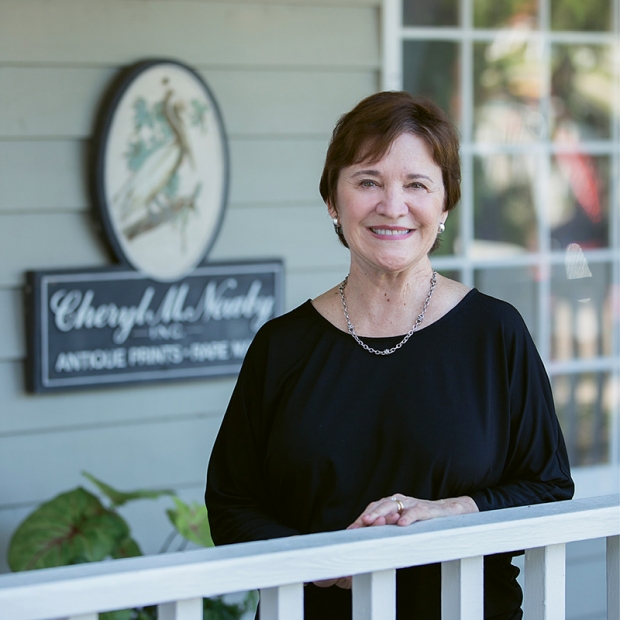At 35 years and counting, the Cheryl Newby Gallery takes the long view on people, art and taste

The art world is a fickle business.
Gallery owners are subject to the whims of public taste, trending media, fair weather collectors and a host of other variables. It takes a discerning eye and a knowledgeable approach to build a credible, high-quality gallery; the owner must not only be selective in choosing the artists to display but also work to earn the trust of artists and clients alike.
In her 35 years in business along the Grand Strand, Cheryl Newby has accomplished this rare feat. As her gallery celebrates its anniversary this fall, Newby reflects on the defining characteristics that have made her business a staple for art enthusiasts and a model for the industry.

Newby’s business was born out of an interest in maps and illustrations fostered over the years as she and her husband, Fred Newby, traveled to Paris, London, Amsterdam and New York. She began showing antique maps and prints in her home in response to requests from friends and subsequently opened her first shop near the current Collector’s Cafe in Myrtle Beach in 1983. After just a year or two, she moved to a more prominent location in Rainbow Harbor, where the second-floor Cheryl Newby Gallery became a landmark.
One driving principle of Newby’s gallery is to make art more accessible to the public by offering a warm environment.
“I have always felt like people are intimidated by fine art galleries,” said Newby. “So people hesitate to come in, and people hesitate to ask questions; they feel like they don’t know what to ask. That’s one thing we try to do here in this gallery: to make people feel very welcome and at ease.”
The nature of the display is another part of creating a hospitable environment.

“I try to set an example for good art and for the way it’s presented,” Newby explained. “We put prices on everything, we put who the artist is, and if it’s an antique, we put the date so they can understand better what they’re looking at. And we love to talk to them about it. If they say, ‘This antique map here says it was done in 1776, but it really means that the original map was done that year; this is a print of that map, right?’ Then we’ll tell them, ‘No, that’s the real deal,’ so then we can get into a conversation about that. We like to help people understand about how the antique prints were made, and we also like to help people understand about how different artists create their work.”
“People really want to learn,” said Kaitee Floyd, gallery director, “so we spend a lot of time talking about the artists with the guests.”
Newby also holds strong principles about space within the gallery and its relation to respect for the artist and his or her work, as well as for the experience of the viewer. She points to a single painting displayed on a wall of her gallery.
“I just feel like that painting is so important, and it took him so much time to make that painting, that it deserves to be looked at by itself and not have my peripheral vision with all this clutter around,” said Newby. “Some galleries display four or five works on top of each other, and I just don’t think it’s fair to the artist.”
In 2000, when Cheryl and Fred Newby moved to Wachesaw Plantation, the Cheryl Newby Gallery moved to the Shops at Oak Lea in Pawleys Island. With that move, Newby expanded the gallery’s offerings with the help of the late Ray Ellis, a renowned impressionist painter who was one of the first artists she represented. Today, while the gallery maintains its specialty in antique maps, nature prints and architectural etchings, it also represents 17 artists who produce in a wide range of media, including painters in watercolor, oil, pastel, and egg tempera and sculptors in bronze and ceramic.

Robin Salmon, vice president of art and historical collections and curator of sculpture at Brookgreen Gardens, said Newby’s success derives partially from her sharp eye for artistic quality and exceptional talent for understanding the needs of both artists and clients.
“I think she has a very good grasp on who her audience is, for one thing, and that she is very keen on making sure that what she’s offering is something that her clients want, or that the brand new person walking through the door will want,” said Salmon. “She also has very high quality artists in her gallery. Over the years, she has maintained good relationships with the artists, and she keeps them; galleries can be a revolving door, but she’s good at building strong relationships with the artists she represents, and they respect her for that.”
Newby’s advice on art? Surround children with art from a young age, ask questions and purchase pieces not because they fit a room or they’re trendy, but because you’re smitten.
“Don’t buy anything if you don’t love it.”